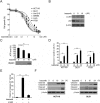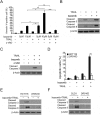Ixazomib promotes CHOP-dependent DR5 induction and apoptosis in colorectal cancer cells
- PMID: 30359552
- PMCID: PMC6370389
- DOI: 10.1080/15384047.2018.1529095
Ixazomib promotes CHOP-dependent DR5 induction and apoptosis in colorectal cancer cells
Abstract
Background: Ixazomib (Ninlaro), a novel proteasome inhibitor, has been developed for the treatment of many cancers and has demonstrated anti-tumor efficacy against various malignancies. However, the mechanism of the anti-tumor effect of ixazomib in colorectal cancer (CRC) cells remains unclear.
Methods: MTS and flow cytometry were performed to determine the effect of ixazomib on CRC cells. Western blotting and real-time RT-PCR were performed to detect ixazomib-induced DR5 upregulation. ChIP was performed to detect CHOP binding to DR5 promoter. Finally, xenograft experiments were carried out to measure the antitumor effect of ixazomib in vivo.
Results: In this study, we revealed the mechanism by which ixazomib inhibits the growth of CRC cells. Our findings indicated that ixazomib treatment induces CHOP-dependent DR5 induction, irrespective of p53 status. Furthermore, DR5 is necessary for ixazomib-mediated apoptosis. Ixazomib also synergized with TRAIL to induce marked apoptosis via DR5 in CRC cells.
Conclusions: Our findings further suggested that ixazomib sensitizes TRAIL/death receptor signaling pathway-targeted CRC and suggested that DR5 induction could be a valuable indicator of ixazomib sensitivity.
Keywords: CHOP; Ixazomib; TRAIL; death receptor 5; extrinsic apoptotic pathway.
Figures






Similar articles
-
Effect of proteasome inhibitors on canine lymphoma cell response to CHOP chemotherapy in vitro.Vet Comp Oncol. 2024 Mar;22(1):96-105. doi: 10.1111/vco.12957. Epub 2024 Jan 18. Vet Comp Oncol. 2024. PMID: 38237918
-
Tanshinone IIA Facilitates TRAIL Sensitization by Up-regulating DR5 through the ROS-JNK-CHOP Signaling Axis in Human Ovarian Carcinoma Cell Lines.Chem Res Toxicol. 2015 Aug 17;28(8):1574-83. doi: 10.1021/acs.chemrestox.5b00150. Epub 2015 Jul 31. Chem Res Toxicol. 2015. PMID: 26203587
-
Lipocalin 2 inversely regulates TRAIL sensitivity through p38 MAPK-mediated DR5 regulation in colorectal cancer.Int J Oncol. 2018 Dec;53(6):2789-2799. doi: 10.3892/ijo.2018.4562. Epub 2018 Sep 14. Int J Oncol. 2018. PMID: 30221676
-
Ixazomib - the first oral proteasome inhibitor.Leuk Lymphoma. 2019 Mar;60(3):610-618. doi: 10.1080/10428194.2018.1523398. Epub 2019 Jan 7. Leuk Lymphoma. 2019. PMID: 30614337 Review.
-
[Pharmacological characteristics and clinical study results of the oral proteasome inhibitor ixazomib (NINLARO® capsules; 2.3 mg, 3 mg, and 4 mg)].Nihon Yakurigaku Zasshi. 2018;151(4):166-178. doi: 10.1254/fpj.151.166. Nihon Yakurigaku Zasshi. 2018. PMID: 29628465 Review. Japanese.
Cited by
-
Antibody-Functionalized Nanoformulations for Targeted Therapy of Colorectal Cancer: A Systematic Review.Int J Nanomedicine. 2022 Oct 31;17:5065-5080. doi: 10.2147/IJN.S368814. eCollection 2022. Int J Nanomedicine. 2022. PMID: 36345508 Free PMC article.
-
Exploring the Mechanisms, Biomarkers, and Therapeutic Targets of TRIM Family in Gastrointestinal Cancer.Drug Des Devel Ther. 2024 Dec 5;18:5615-5639. doi: 10.2147/DDDT.S482340. eCollection 2024. Drug Des Devel Ther. 2024. PMID: 39654601 Free PMC article. Review.
-
High-Throughput Screening of FDA-Approved Drug Library Reveals Ixazomib Is a Broad-Spectrum Antiviral Agent against Arboviruses.Viruses. 2022 Jun 24;14(7):1381. doi: 10.3390/v14071381. Viruses. 2022. PMID: 35891362 Free PMC article.
-
MiR-204-5p regulates SIRT1 to promote the endoplasmic reticulum stress-induced apoptosis of inner ear cells in C57BL/6 mice with hearing loss.PLoS One. 2024 Nov 12;19(11):e0309892. doi: 10.1371/journal.pone.0309892. eCollection 2024. PLoS One. 2024. PMID: 39531447 Free PMC article.
-
Curcumol Overcomes TRAIL Resistance of Non-Small Cell Lung Cancer by Targeting NRH:Quinone Oxidoreductase 2 (NQO2).Adv Sci (Weinh). 2020 Oct 15;7(22):2002306. doi: 10.1002/advs.202002306. eCollection 2020 Nov. Adv Sci (Weinh). 2020. PMID: 33240775 Free PMC article.
References
MeSH terms
Substances
Supplementary concepts
LinkOut - more resources
Full Text Sources
Medical
Research Materials
Miscellaneous
